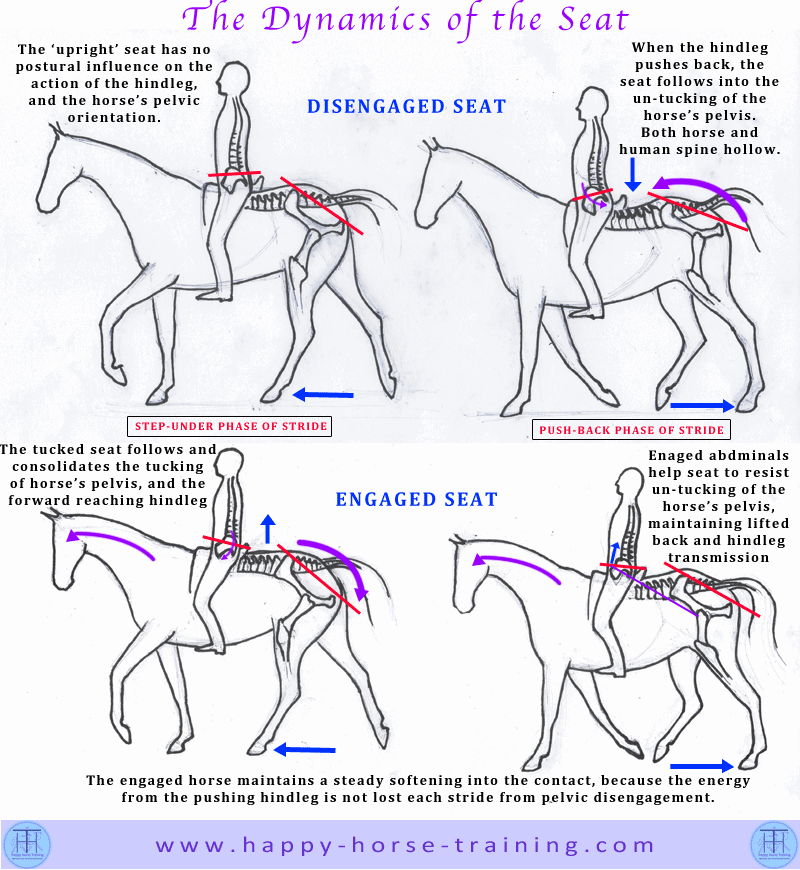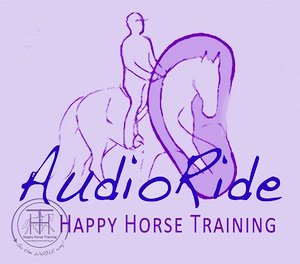Seat Dynamics
This diagram shows the two phases of the hindleg action (illustrated here in walk where it is most clear) and how the rider's seat interacts with these phases of movement.

The
first phase (left-hand diagrams) is when the hindleg reaches under the
horse's body and lands, and the other phase (right-hand diagrams) is when
the hindleg pushes back and stretches out behind the horse's
body. In the horse's natural way of moving, this push back is
accompanied by a tilting forward of the pelvis (un-tucking), with a
dropping (hollowing) of the spine, and a raising of the head.
When
the hindleg steps under the horse (first phase) the pelvis is brought
into a tucked orientation, and the back is lifted. At this moment, the
horse's head will tend to drop.
The top two diagrams show the
interaction of the seat with these two stages when the rider is starting
from the basis of an 'upright seat', where there is little core
engagement. When the hindleg pushes out behind, and the horse's pelvis
disengages, this seat provides no resistance, and is drawn into the
'fork seat' position by the powerful forces of the horse's movement.
In this seat dynamic, both horse and rider's backs become hollow during
this phase, and the horse will 'come against the bit'. There is little
transmission of the energy generated by the hindleg though the horse's
body to maintain a longitudinal, postural stretch towards the bit - it
is all used up in locomotion.
Because the horse's pelvis has
'un-tucked' in the push-back phase of the stride, it is then compromised
in its ability to subsequently reach forwards under the horse's body in
the following phase. The result is hindlegs which work out-behind the
horse, and cannot generate power and collection.
In the bottom
two diagrams, the rider is coming from the basic dynamic of the tucked
pelvis. In this position, when the hindleg reaches under, the seat -
with a stretching of the lumbar back and lifting of the pubic arch -
follows into the accompanying tuck of the horse's pelvis, consolidating
it, and allowing the horse to step further underneath his body.
When
the hindleg then stretches out, the rider's abdominal muscles engage to
RESIST the un-tucking of the seat, and this has the effect of resisting
the horse's own disengagement of the pelvis. Both horse's and rider's
backs are prevented from hollowing, and the horse is therefore able to
maintain longitudinal stretching, and keep softening into the contact.
Clearly, with the engaged seat there is still a change in orientation
in both horse and human pelvises between the two phases of the stride,
but even the relatively small postural influence of the engaged seat on
the horse - resulting in a slight change in the horse's pelvic
orientation - has the power to profoundly alter the horse's balance and
overall biomechanics, and to generate a significant amount of channeled
power.
The postural influence of the engaged rider, therefore,
is not by any means a rigid, unyielding influence - it is a dynamic
interaction with the horse's movement, but what it PROMOTES is
consistency in the horse's ability to lift the back and maintain
transmission of power from haunches through to contact.
If you
would like a step by step guide to learning how to rider in this way,
see 'The Gymnastic Rider' from Happy Horse Training:
Go back to the Dressage Diagrams index page
Return from Seat Dynamics to the Happy Horse Training home page
The pages on HHT are so wide-ranging and interrelated that we strongly recommend you look at the site plan to find other subjects that may interest you.
New from HHT!
AudioRide is a series of exercises designed to listen to while you ride.
Audio descriptions guide you through each step of developing a balanced, dynamic connection with the horse through your position.
This truly innovative learning tool gives you a whole new way of being guided in your riding, in a calm, clear, step-by-step way.
Free Download! Introductory Exercise: Riding in the Now
The Gymnastic Rider eBook
Now available exclusively from HHT!
A unique, comprehensive guide to practical rider biomechanics. This professionally produced eBook takes the rider through the process of developing their body in the specific way that brings the horse's movement into harmony and balance, without force and constraint. Click here for full details, and to download the 15-page introduction to the book for free.
Join the Happy Horse Training group on Facebook!
See and share topical info, news and photo's, and take part in lively discussions.
Click here to go to the HHT group (make sure you log into fb first) and then click on the 'join' button at the top of the page.
Join the Whole Horse Newsletter!
HHT's free monthly newsletter giving you wide-ranging and intelligent insights into holistic horsemanship.
Just enter your details below to join.
Free bonus on the riding position with all new subscriptions: Ten Top Tips To Instantly Improve Your Connection With Your Horse.
Click here to see back issues of The Whole Horse newsletter
Train Your Horse
The Holistic Way
How To Train A Horse Without Force
is a unique guide to training horses through energetic connection and
gymnastic training. Part 1 covers everything on the ground, from
handling to the lungeing technique that develops strength, straightness
and engagement. Comes with a free eBook supplement on Horse Trauma.
Click here for more details.
"As a student of Zen Buddhism for nearly three decades, I've often wondered when someone was going to write the book on Zen and the art of horsemanship, and I think that your emphasis on mindfulness and energy connection gets right at the heart of the matter."
- Prof. Teresa Lloyd, U.S.
Do You Have
A Horse Story
To Share On HHT?
So many people have been through
wonderful experiences with horses, whether in training or otherwise. If
you've made a change in a horse's life - or one has made a change in
yours - tell us about it here.
Learn The Natural Barefoot Trim - The Simple Way
The Simple Seven-Step Natural Trim is a comprehensive step-by-step guide to a cutting-edge barefoot trim. Click here to find out more.
What people say about HHT:
"The riding instruction is outstanding, if instructors in the UK taught this way there would be a lot of happy riders and horses."
"The riding tuition exceeded my hopes and expectations by a long way; giving me an exciting new facet to horsemanship which is lighter. more subtle, more elegant and more meaningful. It is as if a new door has opened bringing more sunlight and air."
"My goodness - what a change has taken place in my riding. I think that I'm starting to sit 'into' the horse rather than on top of him. I felt my horse's movements in a way that has almost never happened before"
Click on Testimonials for more










New! Comments
Anything to say about this page? Leave your comment in the box below.